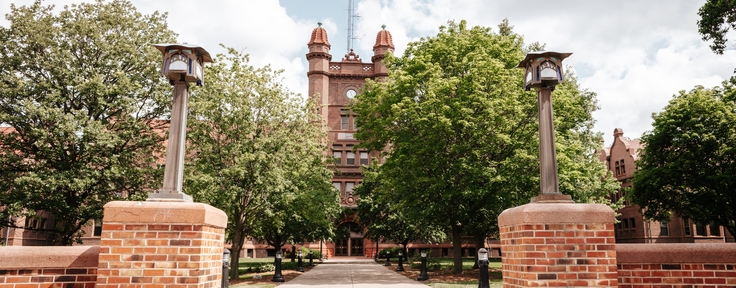Annual Assessment and Multiyear Assessment Trend Reports
All annual assessment reports and multiyear assessment trend reports are available on this web site. These reports are organized by College and University Studies.
Specialized Professional Accreditation (SPA) reports are also included as document links organized by College.
Template Guidelines for Annual Assessment Reports
Leaders of each academic program and university studies requirement complete an annual report on assessment of student learning. The annual reports are based on the following template guidelines:
(1) Goals. State the purpose or mission of your major.
(Express your purpose as valued learning outcomes and connect those goals to the university-wide learning outcome goals: professional, global citizenship, personal life of meaning and value.) You may want to provide an image or description or example of the successful student graduating from your major.
(2) Snapshot. Provide a brief overview of your current situation.
(Provide data on fulltime & adjunct staff, facilities, types & number of students served,听programs, partnerships, number and types and size of courses taught.)
Discuss new initiatives and improvements currently being sought.听
(New courses, changes in curriculum in recent times, improvements or initiatives.)
(3) The Learning Story.听
Explain the typical learning experience provided through your major. How do students learn or engage in experiences leading to fulfilling your learning outcome goals?
(Overview of types of teaching and learning experiences provided, emphasizing the developmental strategy of the curriculum. Include an overview of advising and your assessment of advising processes. Provide a rationale for the range and sequence of courses and learning experiences. Include a description of how a learning community is provided for your majors.)听
Include your curriculum map either in this section or in an appendix.
(4) Assessment Methods.听
Explain your methods and points of data collection for assessing fulfillment of your key learning outcomes. of assessing effectiveness. (How and what you are assessing.)
(Your traditions of assessment, methods of gathering outcome effectiveness data.)
(5) Assessment Data. Report the resulting data on key learning outcomes.
Charts, tables or appendix items.
(6) Analysis of Assessment Results.听
Analyze each key learning outcome goal and rate the quality on it based on your effectiveness ratings rubric scale. (Many plans are using a green light, yellow light, red light scale.) Provide an overall assessment as well for each stated goal of your major.
(7) Improvement Plans.听
Indicate how faculty who deliver and construct the related curriculum review the annual report. Write an overall assessment on the quality of student learning in your major indicating strengths and challenges for review by the responsible faculty. Make recommendations for celebrating and continuing support for effective areas, and make recommendations for improvements or at least indicate areas that should be targeted as a focus for future improvement.
Template Guidelines for Multiyear Trend Reports
Assessment Trend Report
Student Learning Outcomes in [the program name here]听
date
The goal of this report is to evaluate the assessment ofstudent learning outcomes in [the program]. The report addresses four key questions to evaluate the quality of our assessment processes.
(1) How have we sustained the assessment effort over a multi-year period of time?
How many years have you completed an annual assessment report?
_____ 20xx听听听听 _____20xx听听听听 _____20xx听听听 _____20x
[In 2-3 sentences explain how you developed and continue the ongoing assessment process in this program. Note any years the process was not sustained and briefly why. If you have evidence of multi-year assessment other than the annual assessment reports, please explain in 1-2 additional sentences.]
(2) How do we systematically and comprehensively collect and analyze data about student learning?听听 听 听
[In 3-5 sentences explain how data is systematically collected. Who collects data? How is it collected? How is this a systematic random sample of students?]
[In 3-5 sentences or a bulleted list explain what data is collected. Direct data such as portfolios of student work or samples? Indirect data such as surveys or interviews or post-graduate success records? Standardized certification exams or content area exams?]
[In 4-8 sentences explain how the data collected is comprehensive. What are the key learning goals of the program, and how does the data collected assess student learning of each key learning outcome.]
[Provide a chart or table or graph on student performance for each key learning goal over the last 3 years.]
(3) How do we use the analysis to improve curriculum and pedagogy and to inform decisions about budgets and strategic priorities?
[In 2-3 sentences explain when, where and how you share the annual assessment report with faculty in your program (program meeting,retreat, workshop, online, email) and how the faculty discuss the significance of the assessment data results.]
[In 3-5 sentences (or a bullet list) discuss improvement initiatives that came from your assessment process. Curriculum changes? New courses? New course content or emphasis? Pedagogical reforms? Learning environment changes, etc.]
(4) How do we evaluate, modify, and continue to improve the student learning assessment process in this program?
[In 3-4 sentences explain how your assessment process has evolved or developed over time. What changes have you made to your assessmentprocess? What would you still like to improve?]
Evaluation from Leadership Team (includes Academic Deans, Program Leaders, and Focus Visit Report Writers)
Rating:
|
Academic Program 听 听 |
Goal 1听 (multi-year) 听 |
Goal 2 (data collection) 听 |
Goal 3 (use assessment to improve) 听 |
Goal 4 (improve assessment process) 听 |
Total 听 |
|
[Program Name ] |
X |
X |
X |
X |
X |
Based on the four questions, the [Program Name] is [rated as rating] and we conclude that [Program Name] [brief notes about strengths and weaknesses].
